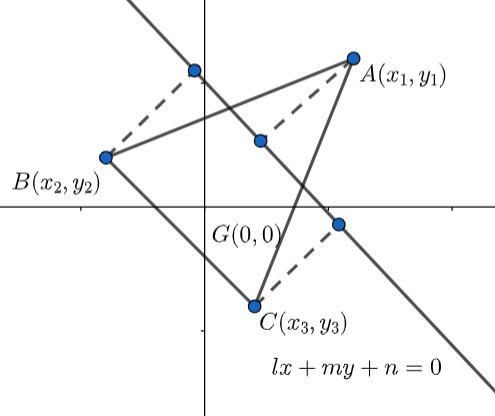Question
Question: If three vertices of a triangle ABC are \(A\left( {{x}_{1}},{{y}_{1}} \right),B\left( {{x}_{2}}{{y}_...
If three vertices of a triangle ABC are A(x1,y1),B(x2y2),C(x3,y3). lx+my+n=0 is an equation of the line L. If the centroid of the triangle ABC is at the origin and algebraic sum of the length of the perpendicular from the vertices of triangle ABC on the line L is equal to 1, then sum of the squares of reciprocals of the intercepts made by L on the coordinate axes is equal to:
A) 0
B) 4
C) 9
D) 16
Solution
Hint: The perpendicular distance from point (x1y1) to line ax+by+c=0 is given as d=a2+b2ax1+by1+c.
Complete step-by-step answer:
We are given a triangle ABC whose vertices are given as A(x1y1),B(x2y2)&C(x3,y3) .

Also , the given equation of the line is
L≡lx+my+n=0
Now , in the question it is given that the centroid is at the origin i.e. (0,0) .
We know , if a triangle has vertices (x1,y1),(x2,y2) and (x3,y3) then , its centroid is given as
((3x1+x2+x3),(3y1+y2+y3)) .
So ,(3x1+x2+x3,3y1+y2+y3)=(0,0)
⇒3x1+x2+x3=0
Or , x1+x2+x3=0..........(i)
And , 3y1+y2+y3=0
Or , y1+y2+y3=0...........(ii)
Now , we know the perpendicular distance of point (x1,y1) from the line ax+by+c=0 is given by
a2+b2ax1+by1+c .
Now, the given equation of line is L≡lx+my+n=0 .
In the question , it is given that the algebraic sum of perpendicular distances of the vertices from the line is equal to 1 .
⇒l2+m2(lx1+my1+n)+l2+m2(lx2+my2+n)+l2+m2(lx3+my3+n)=1
⇒l2+m2l(x1+x2+x3)+m(y1+y2+y3)+3n=1.........(iii)
Now , we will substitute (i) and (ii) in equation (iii) .
On substituting (i) and (ii) in equation (iii) , we get
l2+m23n=1
⇒3n=l2+m2
Now , we will square both sides .
On squaring both sides , we get
9n2=l2+m2............(iv)
Now , the given line is
lx+my+n=0⇒lx+my=−n⇒−nlx+−nmy=1⇒(l−n)x+(m−n)y=1........(v)
Now we know , if a is the x -intercept and b is the y –intercept formed by a line with the coordinate axes, then equation of line is written as
ax+by=1
Comparing with (v) , we get:
a=l−n&b=m−n
So , sum of squares of reciprocal of the intercept is given as
a21+b21=(l−n)21+(m−n)21=n2l2+n2m2=n2l2+m2...........(vi)
Now , from (iv) we have l2+m2=9n2
Substituting in equation (vi) , we get
a21+b21=n29n2=9
Hence , the sum of the squares of reciprocals of the intercepts made by L on the coordinate axes is equal to 9 .
Note: While simplifying the equations, please make sure that sign mistakes do not occur. These mistakes are very common and can cause confusions while solving. Ultimately the answer becomes wrong. So, sign conventions should be carefully taken.
